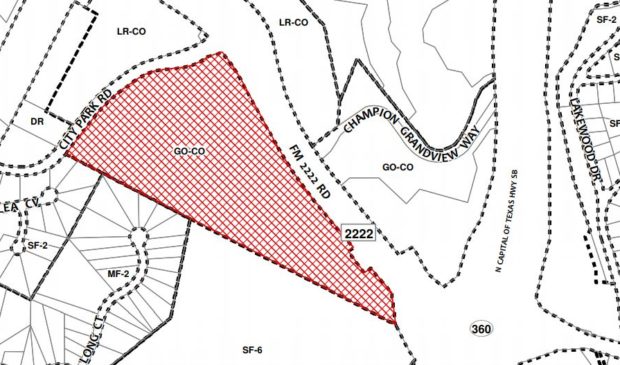Champion tract returning to Council
Thursday, November 30, 2017 by
Jo Clifton Because neighborhood activists won their open meetings lawsuit against the city last month, City Council will be reconsidering an ordinance that amends an old settlement agreement related to development on the Champion tract at 6409 City Park Road at next week’s meeting.
District Judge Scott Jenkins ruled that the city violated the Texas Open Meetings Act in November 2016 by failing to disclose on the Council agenda that Council would be voting on waivers of the Hill Country Roadway Ordinance and the Lake Austin Watershed Ordinance when it voted to change the settlement agreement.
Last year, Council approved changing those regulations on a vote of 7-4, but a neighborhood group called the Lake Austin Collective hired attorney Bill Aleshire, who argued successfully that the city had once again violated the open meetings law. Aleshire won a similar case for Brian Rodgers, who sued over allegations concerning the open meetings law related to the Pilot Knob subdivision.
There will be no question about what Council is voting on this time because the agenda clearly states that it will be considering an amendment to the settlement agreement and names the two ordinances that will be modified.
There will be a lot of questions, however, about whether the plan it will be considering is environmentally superior to what the developer could build without the variances. Attorney Bobby Levinski, who is helping the neighborhood, told the Austin Monitor that despite city staff’s assertions that the plan is superior to what could otherwise be built, he and the neighbors disagree.
Attorney Richard Suttle represents the developer. A year ago, Suttle was able to win a zoning change on the 45-acre tract from General Office (GO-CO) to Multifamily-Moderate Density (MF-4-CO) with a conditional overlay. Levinski said that they would no longer be talking about the zoning case, “just about whether the environmental variances should apply.”
According to a memo from the city’s environmental officer, Chuck Lesniak, the developer will “set aside approximately 30 acres of the 45-acre tract in a conservation easement and protect several critical environmental features on the property.” Lesniak wrote the memo on Nov. 9, 2016, but it is part of the backup material for Council’s Dec. 7 meeting also.
The neighborhood is particularly concerned about structural excavation on the sensitive site. Comparing what the applicant and the staff agreed to, neighbor Carol Lee has provided a chart that shows that under the 1993 regulations, there would be a maximum of 8 feet of structural excavation. However, under the agreement approved last year, the developer can excavate up to 34 feet.
Levinski said, “I think we would argue when it was first considered there was very little consideration” for what the Hill Country Roadway Ordinance would allow.
In addition, he said Council needs to consider the difference between the number of trips that will be generated by 300 apartments compared to a 30,000-square-foot office building. The number goes from 500 to 2,100 trips per day, Levinski said.
According to Lesniak, the Hill Country Roadway Ordinance requires a 100-foot setback from RM 2222, but under the original settlement agreement this setback is only 25 feet. The memo states that the developer has agreed to access to RM 2222 with only right-in and right-out, but the setback remains at 25 feet.
There may also be questions about how the settlement, which is in effect approval of a site plan with the noted variances, landed on the Council agenda without going through a hearing at the Zoning and Platting Commission.
Jerry Rusthoven, assistant director of the Planning and Zoning Department, told the Monitor that he found out that the settlement was on the agenda when he read the preliminary agenda. The planning department was not involved, he said.
Map courtesy of the city of Austin.
The Austin Monitor’s work is made possible by donations from the community. Though our reporting covers donors from time to time, we are careful to keep business and editorial efforts separate while maintaining transparency. A complete list of donors is available here, and our code of ethics is explained here.
You're a community leader
And we’re honored you look to us for serious, in-depth news. You know a strong community needs local and dedicated watchdog reporting. We’re here for you and that won’t change. Now will you take the powerful next step and support our nonprofit news organization?




